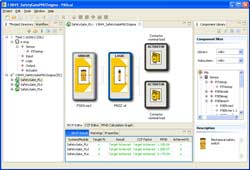
Posted to News on 16th Oct 2008, 14:15
PAScal safety calculator - a review by MachineBuilding.net
Apart from when designing relatively simple machines that can conform to the requirements of EN 954-1 (Safety of machinery, Safety-related parts of control systems, Part 1: General principles for design), machine builders and system integrators today need to work to either EN ISO 13849-1 (Safety of machinery, Safety-related parts of control systems, Part 1: General principles for design) or EN/IEC 62061 (Safety of machinery, Functional safety of safety-related electrical, electronic and programmable electronic control systems). Compared with EN 954-1, both of these machinery safety standards are relatively complex, largely because they use the concept of functional safety and they call for quantitative assessments. Of course, in the UK the three standards are known as BS EN 954-1, BS EN ISO 13849-1 and BS EN 62061.

Various tools are available to help designers comply with these two standards, one of which is the Pilz PAScal (safety calculator) software tool (currently at version 1.2.3). Users can choose whether to work to EN ISO 13849-1 or EN/IEC 62061 when they start a new project, and there is also a choice of languages (English, German, French, Italian, Spanish and Japanese). PAScal 1.2.3 is compatible with Microsoft Windows XP and Vista.
PAScal appears to be very good at what it does, but note that PAScal is a verification calculator, not a design tool. A prerequisite, therefore, is that users need a good understanding of the relevant machinery safety standard and to have already designed the safety circuit before turning to PAScal.
When opening PAScal, users are first presented with a disclaimer and a helpful reminder to check that the installed component libraries are up to date. There is a link to a page on the Pilz website from where new libraries can be downloaded, though the web page does not state the date of the libraries, so these cannot be checked against the displayed dates for the installed libraries.
Getting started
A comprehensive Help system is provided, including a glossary of terms and context-sensitive tips and help. In addition, the package comes with 20 example projects, 10 for each of EN ISO 13849-1 and EN/IEC 62061. These cover safety-related control circuits utilising Pilz PNOZsigma slimline safety relays, PNOZ X-range safety relays, PNOZmulti configurable safety controllers, PSS programmable safety systems (safety PLC type controllers), and the SafetyBUS p safe fieldbus.
The default screen layout places a Project Directory and Workflow pane on the left-hand side, a Component Library pane on the right, a pane at the bottom for SRCF Results, Warnings and Properties, and the main central area for the SRCF Editor, CCF Editor and PFHd Calculation Graph. All of these can be resized, minimised, maximised or dragged to new positions if preferred. A maximum of five projects can be open simultaneously.
On the whole the software is intuitive. For example, the Project Directory can be collapsed or expanded, so users can drill down from the project to the safety functions and on down to individual components. Also the drag-and-drop SRCF Editor is particularly user-friendly, showing the sensors, inputs, logic, outputs and actuators in a clear, logical way (see image above or a larger version). Another useful graphical feature is the 'Contribution to PL' bar chart that is available when working to ISO 13849-1.
To help users progress their projects as smoothly as possible, PAScal uses a six-step workflow. As each step is completed, the workflow uses a tick (check mark) to indicate that the task has been completed. The six steps are:
- Create a project
- Create a new SRCF
- Create a new subsystem
- Assign a component
- Open CCF Editor
- Generate report
Automated calculations
Of course the main aim of the PAScal calculator is to support users in determining the PL (performance level) or SIL (safety integrity level) for safety functions in accordance with EN ISO 13849-1 and EN/IEC 62061, respectively. It also performs the necessary PFHd (probability of dangerous failure per hour) calculations required for EN/IEC 62061, and verifies that the specified PL or SIL has been achieved by the proposed safety-related control system.
Pilz has developed PAScal for use primarily in assessing circuits comprising its own safety components. However, users can import other component libraries, provided sufficient data is available for these components.
A demo version of the software can be downloaded free of charge from www.pilz.co.uk/products/software/index.en.jsp (registration is required, and the large file size may cause difficulties for some users). The demo version is an excellent way to try the software, as most functions operate as per the licensed version. However, the report generation tool is disabled and each project is restricted to a maximum of three safety-related control functions. If you routinely use Pilz safety components then this tool could save you a great deal of time. And if you do not use Pilz components, then it may well be worth your while taking the time to create and import a component library for the components that you do use.
Jonathan Severn [email protected]
Want the latest machine building news straight to your inbox? Become a MachineBuilding member for free today >>















